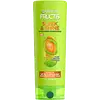What's inside
What's inside
 Key Ingredients
Key Ingredients

 Benefits
Benefits

 Concerns
Concerns

 Ingredients Side-by-side
Ingredients Side-by-side

Water
Skin ConditioningCetearyl Alcohol
EmollientBehentrimonium Chloride
PreservativeAmodimethicone
Parfum
MaskingIsopropyl Alcohol
SolventPhenoxyethanol
PreservativePyrus Malus Fruit Extract
Skin ConditioningBenzoic Acid
MaskingTrideceth-6
EmulsifyingPotassium Hydroxide
BufferingArgania Spinosa Kernel Oil
EmollientNiacinamide
SmoothingPyridoxine Hcl
Skin ConditioningHexyl Cinnamal
PerfumingCetrimonium Chloride
AntimicrobialCitric Acid
BufferingSaccharum Officinarum Extract
MoisturisingBenzyl Alcohol
PerfumingLinalool
PerfumingAmyl Cinnamal
PerfumingTocopherol
AntioxidantHydroxypropyltrimonium Lemon Protein
HumectantCI 19140
Cosmetic ColorantCI 15985
Cosmetic ColorantCitrus Limon Peel Extract
EmollientLeuconostoc/Radish Root Ferment Filtrate
AntimicrobialCamellia Sinensis Leaf Extract
AntimicrobialWater, Cetearyl Alcohol, Behentrimonium Chloride, Amodimethicone, Parfum, Isopropyl Alcohol, Phenoxyethanol, Pyrus Malus Fruit Extract, Benzoic Acid, Trideceth-6, Potassium Hydroxide, Argania Spinosa Kernel Oil, Niacinamide, Pyridoxine Hcl, Hexyl Cinnamal, Cetrimonium Chloride, Citric Acid, Saccharum Officinarum Extract, Benzyl Alcohol, Linalool, Amyl Cinnamal, Tocopherol, Hydroxypropyltrimonium Lemon Protein, CI 19140, CI 15985, Citrus Limon Peel Extract, Leuconostoc/Radish Root Ferment Filtrate, Camellia Sinensis Leaf Extract
Water
Skin ConditioningSodium Laureth Sulfate
CleansingErythritol
HumectantCoco-Glucoside
CleansingGlycol Distearate
EmollientCocamidopropyl Betaine
CleansingCetyl Alcohol
EmollientCocamide Mea
EmulsifyingGlyceryl Oleate
EmollientParfum
MaskingPolyquaternium-10
Benzyl Alcohol
PerfumingPPG-9
Skin ConditioningDisodium EDTA
Glycine
BufferingSodium Chloride
MaskingPolyquaternium-39
Malic Acid
BufferingCocos Nucifera Oil
MaskingSodium Hydroxide
BufferingMethylchloroisothiazolinone
PreservativeMethylisothiazolinone
PreservativeWater, Sodium Laureth Sulfate, Erythritol, Coco-Glucoside, Glycol Distearate, Cocamidopropyl Betaine, Cetyl Alcohol, Cocamide Mea, Glyceryl Oleate, Parfum, Polyquaternium-10, Benzyl Alcohol, PPG-9, Disodium EDTA, Glycine, Sodium Chloride, Polyquaternium-39, Malic Acid, Cocos Nucifera Oil, Sodium Hydroxide, Methylchloroisothiazolinone, Methylisothiazolinone
 Reviews
Reviews

Ingredients Explained
These ingredients are found in both products.
Ingredients higher up in an ingredient list are typically present in a larger amount.
Benzyl Alcohol is most commonly used as a preservative. It also has a subtle, sweet smell. Small amounts of Benzyl Alcohol is not irritating and safe to use in skincare products. Most Benzyl Alcohol is derived from fruits such as apricots.
Benzyl Alcohol has both antibacterial and antioxidant properties. These properties help lengthen the shelf life of products. Benzyl Alcohol is a solvent and helps dissolve other ingredients. It can also improve the texture and spreadability.
Alcohol comes in many different forms. Different types of alcohol will have different effects on skin. This ingredient is an astringent alcohol.
Using high concentrations of these alcohols are drying on the skin. They may strip away your skin's natural oils and even damage your skin barrier. Astringent alcohols may also irritate skin.
Other types of astringent alcohols include:
According to the National Rosacea Society based in the US, you should be mindful of products with these alcohols in the top half of ingredients.
Any type of sanitizing product will have high amounts of alcohol to help kill bacteria and viruses.
Learn more about Benzyl AlcoholParfum is a catch-all term for an ingredient or more that is used to give a scent to products.
Also called "fragrance", this ingredient can be a blend of hundreds of chemicals or plant oils. This means every product with "fragrance" or "parfum" in the ingredients list is a different mixture.
For instance, Habanolide is a proprietary trade name for a specific aroma chemical. When used as a fragrance ingredient in cosmetics, most aroma chemicals fall under the broad labeling category of “FRAGRANCE” or “PARFUM” according to EU and US regulations.
The term 'parfum' or 'fragrance' is not regulated in many countries. In many cases, it is up to the brand to define this term.
For instance, many brands choose to label themselves as "fragrance-free" because they are not using synthetic fragrances. However, their products may still contain ingredients such as essential oils that are considered a fragrance by INCI standards.
One example is Calendula flower extract. Calendula is an essential oil that still imparts a scent or 'fragrance'.
Depending on the blend, the ingredients in the mixture can cause allergies and sensitivities on the skin. Some ingredients that are known EU allergens include linalool and citronellol.
Parfum can also be used to mask or cover an unpleasant scent.
The bottom line is: not all fragrances/parfum/ingredients are created equally. If you are worried about fragrances, we recommend taking a closer look at an ingredient. And of course, we always recommend speaking with a professional.
Learn more about ParfumWater. It's the most common cosmetic ingredient of all. You'll usually see it at the top of ingredient lists, meaning that it makes up the largest part of the product.
So why is it so popular? Water most often acts as a solvent - this means that it helps dissolve other ingredients into the formulation.
You'll also recognize water as that liquid we all need to stay alive. If you see this, drink a glass of water. Stay hydrated!
Learn more about Water